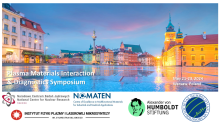NOMATEN - blog
Understanding fuel rod cladding corrosion processes remains a challenge in terms of the impact of alloying elements on the oxidation rate. The corrosion mechanisms of zirconium alloys - Zircaloy-4 and M5 - are not yet fully understood, due to the complexity of these materials, the environment and ionizing radiation conditions. The aim of our research
Three Polish Centers of Excellence that received funding from Horizon 2020: Sano, ENSEMBLE3 and NOMATEN - summed up their 5-year activities at a conference dedicated to the "Teaming for Excellence" competition. Representatives of the following projects recently received a grant from Horizon Europe: TRIO-VI, AstroCENT Plus and P4Health, and they also discussed their plans. The meeting was hosted by the National Center for Research and Development.
Dear Colleagues, Friends,
NOMATEN Centre of Excellence located at the National Centre for Nuclear Research (NCBJ) invites you to save the date and make plans to join us for the International Radiopharmaceutical Conference NOMRad which will be held June 25 - 27, 2024 at the NOVOTEL hotel located in the city center of Warsaw. NOMRad Conference is organized in the frame of project granted by the Polish National Agency for Academic Exchange (NAWA) under Welcome to Poland programme, as well as the NOMATEN Teaming Coordination and Support action.
The use of atomistic simulations is extremely helpful in analysing the thermodynamics in metallic systems. DFT-based methods provide a powerful tool to describe phase stability, enthalpy and/or magnetic configurations, but are constrained to small systems due to a large computational cost.
The talk will provide an overview of activities held by Belgian Nuclear Research Center (SCK CEN). Then, the Fusion R&D programme carried over last 10 years will be presented. And finally, the current vision and near future infrastructural developments at SCK CEN will be presented
NOMATEN hosts a Symposium on Plasma Materials Interactions and Diagnostics from May 21-23, 2024. This hybrid event offers in-person and virtual participation options, aiming to bridge scientific collaborations between Poland and the EU. We are honored to feature Dr. Marcin Jakubowski from the Max Planck Institute for Plasma Physics, Dr. Andrea Sand from Aalto University, Dr. Christophe Ortiz from CIEMAT, Dr. Miroslaw Zlobinski from Forschungszentrum Jülich, and Dr. Roman Zagórski from National Centre for Nuclear Research as a distinguished speakers.
Polymer derived ceramics, PDCs, are a group of silicon-based ceramic materials that are gaining increasing interest. The most common ones are carbide, oxycarbide, oxynitride, or silicon nitride. They are characterized by high thermomechanical stability, oxidation and chemical resistance, as well as bioactive and catalytic properties. These materials are obtained based on the pyrolysis of preceramic precursors, most often organosilicon polymers. Thanks to this approach...
Structural nuclear materials are subjected to neutron irradiation at elevated temperature, thereby affecting the operational lifetime of various critical reactor components. Dose-dependent material damage directly depends on dislocation-mediated plasticity mechanisms and their interactions with the irradiation defect microstructures, in the form of interstitial and vacancy clusters. Corresponding plastic strain spreading mechanisms...
As we head towards 2030 and 55% carbon emission reduction targets with the ultimate goal of net zero carbon by 2050. It has become evident that materials and the source of such materials will play a key role for future generations of devices and products. This along with the depletion of petroleum resources and their associated environmental...
Oxide dispersion-strengthened materials are reinforced by a (Y, Ti, O) nano-oxide dispersion and thus can be considered as nanostructured materials. Designed to serve in extreme environment – i.e., a nuclear power plant – the challenge for ODS steels is to preserve the nano-oxide dispersion under irradiation in order to maintain the excellent creep properties of the alloy in the reactor. Under irradiation...

Copyright NOMATEN 2017-2024







